This post was originally published on Eco Watch
Shampoo, conditioner and sunscreens may be part of many people’s self-care routines, but most of these products contain chemicals that are harmful to animals and the environment.
New research has found that, contrary to long-held beliefs, some of the ingredients in personal care products, such as softening agents in shampoos, are harmful to aquatic life.
“We have conducted the first study in the world to investigate this. The substances do not penetrate the animals’ cells, but rather stick to the surface of the animal. This physically affects the animal, making it unable to move as well, and it impairs its ability to ingest food,” said senior researcher Hans Sanderson with the Department of Environmental Science at Aarhus University in a press release from the university.
Human hair is made of keratin, which has a negative charge that makes hair dull and frizzy. Most shampoos contain positively charged substances that work as softening agents by binding to hair to make it less frizzy and give it shine.
It had previously been thought that softening agents did not pose any environmental hazards, since they are large molecules that can’t penetrate plant and animal cells.
But new research has shown this not to be true. Softening agents impact small aquatic animals like daphnia, who live in lakes, rivers and streams, making it hard for them to find sustenance and ultimately killing them.
Softening agents added to shampoos, conditioners and a wide array of personal care products are types of the chemical group polymers.
Sanderson and colleagues tested some types of softening agents, but they were just a small percentage of the 25,000 used globally.
Softening agents aren’t only used in personal care products, they are also added to wastewater treatment plants to aid in purification of the water by binding to other molecules and making them easier to filter.
“In the EU, lawmakers are starting to realize that we also need to investigate substances that do not penetrate cells. New regulations of these substances are expected. That’s why I’ve conducted these studies at the request of the industry,” Sanderson said.
The researchers investigated how two species of daphnia — tiny freshwater crustaceans — were affected by the substances. Daphnia eat bacteria, plant matter and algae, and play an essential role in the ecosystem by purifying the water and serving as a food source for a wide variety of fish.
When too many of the softening agents end up in the water, they harm the daphnia.
“We tested two different species. In the first species, the sticky substances attached itself to its body, significantly hindering its movements. This affects the animals’ survival chances—and therefore has a strong negative effect on it. The second species was slightly less affected,” Sanderson explained.
Sanderson said the findings suggest regulations should be established and more substances need to be investigated.
“These softening agents, which are large molecules, are very difficult to investigate for their harmful effects because they bind to everything. To investigate them as accurately as possible, we need to imitate the conditions in streams and lakes to see the real effect,” Sanderson said. “We succeeded in doing so, and we have developed a method to test the environmental effects of many more of these substances.”
Sanderson emphasized that most products people use contain the substances — even those displaying the Nordic Swan Ecolabel.
“Even the Swan-labeled neutral products contain some of these substances. It may be that producers of these products will have to look for a range of other substances in the future,” Sanderson said.
Another concern is whether the substances should continue to be used at wastewater treatment plants.
“The substances are added to filter out other substances from the wastewater. Therefore we need to address the question of what is worst for the environment: these substances or the substances they help to filter out,” Sanderson said.
The study, “Acute and chronic toxicity of cationic polyquaterniums of varying charge density and molecular weight to Daphnia magna and Ceriodaphnia dubia,” was published in the journal Aquatic Toxicology.
In Denmark, 99 species of daphnia, commonly called water fleas, are found primarily in freshwater. Creative Commons / Store Norske Leksikon
The post Personal Care Products Like Shampoo Can Harm Aquatic Life: Study appeared first on EcoWatch.





0 Comments